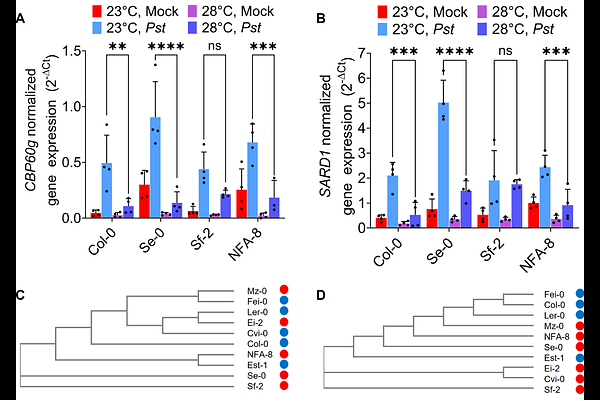Distinct mechanisms of plant immune resilience revealed by natural variation in warm temperature-modulated disease resistance among Arabidopsis accessions

Distinct mechanisms of plant immune resilience revealed by natural variation in warm temperature-modulated disease resistance among Arabidopsis accessions
Rossi, C. A. M.; Patel, D. N.; Castroverde, C. D. M.
AbstractElevated temperature suppresses production of the key plant defence hormone salicylic acid (SA). Heat-mediated SA suppression and resulting plant vulnerability are due to downregulated expression of CALMODULIN BINDING PROTEIN 60-LIKE G (CBP60g) and SYSTEMIC ACQUIRED RESISTANCE DEFICIENT 1 (SARD1), which encode master regulators of plant immunity. However, previous studies in Arabidopsis thaliana plants have primarily focused on the accession Columbia-0 (Col-0), while the mechanisms governing the intraspecific variation in Arabidopsis immunity under elevated temperature has remained unknown. Here we show that BASIC HELIX LOOP HELIX 059 (bHLH059), a thermosensitive SA regulator at non-stress temperatures, does not regulate immune suppression under warmer temperatures. In agreement, temperature-resilient and -sensitive Arabidopsis accessions based on disease resistance to the bacterial pathogen Pseudomonas syringae pv. tomato (Pst) DC3000 did not correlate with bHLH059 sequence polymorphisms. Finally, we found that different temperature-resilient accessions exhibit varying CBP60g and SARD1 expression profiles, potentially revealing both CBP60g/SARD1-dependent and independent mechanisms of plant immune resilience to warming temperature. Collectively, this study has unveiled the intraspecific diversity of Arabidopsis immune responses under warm temperatures, which is differentially mediated by the master transcription factors CBP60g and SARD1. Dissecting the mechanisms underlying temperature-modulated plant immunity aid in predicting plant responses to climate change and provide foundational knowledge for climate-resilient crop engineering.